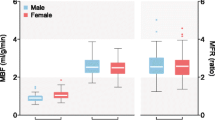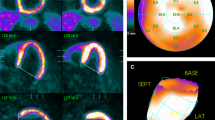Abstract
Background
Myocardial perfusion imaging with treadmill exercise nitrogen-13 (13N)-ammonia positron emission tomography (PET) presents a logistical challenge. We investigated the feasibility of exercise treadmill (GXT) 13N-ammonia PET MPI using an off-site cyclotron for production of 13N-ammonia.
Methods
Thirty-three patients underwent GXT 13N-ammonia PET MPI over 23 months. 13N-ammonia doses were prepared at an off-site cyclotron. Patients underwent 13N-ammonia resting and 13N-ammonia GXT emission and transmission scans at our facility. Image quality, perfusion data, and clinical variables were evaluated.
Results
We analyzed 33 patients (7/26 female/male). Mean age was 63 ± 12 years and mean BMI was 33.7 ± 6.9. GXT PET was feasible in all patients. Image quality was good in 29 patients, adequate in 3, and severely compromised in 1 patient. Summed stress score was 4.5 ± 5.7. Resting and GXT left ventricular ejection fractions were 63.7 ± 10.9% and 66.3 ± 13.1%. TID ratio was 1.0 ± 0.1.
Conclusions
Treadmill exercise 13N-ammonia PET is feasible in a large medical center without access to an on-site cyclotron. This technique requires close coordination with an off-site cyclotron but expands the role of PET to patients for whom exercise is more appropriate than pharmacologic stress imaging.





Similar content being viewed by others
Abbreviations
- ALARA:
-
As low as reasonably achievable
- CABG:
-
Coronary artery bypass graft
- CAD:
-
Coronary artery disease
- EOS:
-
End of synthesis
- FFR:
-
Fractional flow reserve
- MPI:
-
Myocardial perfusion imaging
- PET:
-
Positron emission tomography
- SPECT:
-
Single-photon emission computed tomography
- GXT:
-
Exercise treadmill test
References
Bateman TM, Heller GV, McGhie AI, Friedman JD, Case JA, Bryngelson JR et al (2006) Diagnostic accuracy of rest/stress ECG-gated Rb-82 myocardial perfusion PET: Comparison with ECG-gated Tc-99m sestamibi SPECT. J Nucl Cardiol 13:24-33
Yoshinaga K, Chow BJ, Williams K, Chen L, deKemp RA, Garrard L et al (2006) What is the prognostic value of myocardial perfusion imaging using rubidium-82 positron emission tomography? J Am Coll Cardiol 48:1029-39
Mc Ardle BA, Dowsley TF, deKemp RA, Wells GA, Beanlands RS (2012) Does rubidium-82 PET have superior accuracy to SPECT perfusion imaging for the diagnosis of obstructive coronary disease?: A systematic review and meta-analysis. J Am Coll Cardiol 60:1828-37
Parker MW, Iskandar A, Limone B, Perugini A, Kim H, Jones C et al (2012) Diagnostic accuracy of cardiac positron emission tomography versus single photon emission computed tomography for coronary artery disease: A bivariate meta-analysis. Circ Cardiovasc Imaging 5:700-7
Aggarwal NR, Drozdova A, Askew JW 3rd, Kemp BJ, Chareonthaitawee P (2015) Feasibility and diagnostic accuracy of exercise treadmill nitrogen-13 ammonia PET myocardial perfusion imaging of obese patients. J Nucl Cardiol 22:1273-80
Chow BJ, Beanlands RS, Lee A, DaSilva JN, deKemp RA, Alkahtani A et al (2006) Treadmill exercise produces larger perfusion defects than dipyridamole stress N-13 ammonia positron emission tomography. J Am Coll Cardiol 47:411-16
Pieper J, Patel VN, Escolero S, Nelson JR, Poitrasson-Rivière A, Shreves CK et al (2019) Initial clinical experience of N13-ammonia myocardial perfusion PET/CT using a compact superconducting production system. J Nucl Cardiol. https://doi.org/10.1007/s12350-019-01886-7
Di Carli MF, Dorbala S, Meserve J, El Fakhri G, Sitek A, Moore SC (2007) Clinical myocardial perfusion PET/CT. J Nucl Med 48:783-3
Nakazato R, Berman DS, Alexanderson E, Slomka P (2013) Myocardial perfusion imaging with PET. Imaging Med 5:35-46
Henzlova MJ, Duvall WL, Einstein AJ, Travin MI, Verberne HJ (2016) ASNC imaging guidelines for SPECT nuclear cardiology procedures: Stress, protocols, and tracers. J Nucl Cardiol 23:606-39
Dilsizian V, Bacharach SL, Beanlands RS, Bergmann SR, Delbeke D, Dorbala S et al (2016) ASNC imaging guidelines/SNMMI procedure standard for positron emission tomography (PET) nuclear cardiology procedures. J Nucl Cardiol 23:1187-26
Chow BJ, Ananthasubramaniam K, de Kemp RA, Dalipaj MM, Beanlands RS, Ruddy TD (2005) Comparison of treadmill exercise versus dipyridamole stress with myocardial perfusion imaging using rubidium-82 positron emission tomography. J Am Coll Cardiol 45:1227-34
Harnett DT, Hazra S, Maze R, Mc Ardle BA, Alenazy A, Simard T et al (2019) Clinical performance of Rb-82 myocardial perfusion PET and Tc-99m-based SPECT in patients with extreme obesity. J Nucl Cardiol 26:275-3
Taqueti VR (2019) Myocardial perfusion imaging in extreme obesity: Leveraging modern technologies to meet a modern challenge. J Nucl Cardiol 26:284-7
Murthy VL, Naya M, Foster CR, Hainer J, Gaber M, Di Carli G et al (2011) Improved cardiac risk assessment with noninvasive measures of coronary flow reserve. Circulation 124:2215-24
Ziadi MC, Dekemp RA, Williams K, Guo A, Renaud JM, Chow BJ et al (2012) Does quantification of myocardial flow reserve using rubidium-82 positron emission tomography facilitate detection of multivessel coronary artery disease? J Nucl Cardiol 19:670-80
Fukushima K, Javadi MS, Higuchi T, Lautamaki R, Merrill J, Nekolla SG et al (2011) Prediction of short-term cardiovascular events using quantification of global myocardial flow reserve in patients referred for clinical 82Rb PET perfusion imaging. J Nucl Med 52:726-2
Herzog BA, Husmann L, Valenta I, Gaemperli O, Siegrist PT, Tay FM et al (2009) Long-term prognostic value of 13N-ammonia myocardial perfusion positron emission tomography added value of coronary flow reserve. J Am Coll Cardiol 54:150-6
Cerqueira MD, Allman KC, Ficaro EP, Hansen CL, Nichols KJ, Thompson RC et al (2010) Recommendations for reducing radiation exposure in myocardial perfusion imaging. J Nucl Cardiol 17:709-18
Case J, deKemp R, Slomka P, Smith M, Heller G, Cerqueira M (2017) Status of cardiovascular PET radiation exposure and strategies for reduction: An information statement from the cardiovascular PET task force. J Nucl Cardiol 24:1427-39
Stabin MG (2008) Radiopharmaceuticals for nuclear cardiology: Radiation dosimetry, uncertainties, and risk. J Nucl Med 49:1555-63
Maddahi J (2012) Properties of an ideal PET perfusion tracer: New PET tracer cases and data. J Nucl Cardiol 19(Suppl 1):S30-7
Ikotun O, Clarke B, Sunderland J (2012) A snapshot of United States PET cyclotron and radiopharmaceutical production operations and locations. J Nucl Med 53:1085
Acknowledgements
The authors gratefully acknowledge from Aurora Cardiovascular and Thoracic Services Susan Nord and Jennifer Pfaff for editorial preparation of the manuscript and Brian Miller and Brian Schurrer for their help with the figures.
Funding
This research did not receive any specific Grant from funding agencies in the public, commercial, or not-for-profit sectors.
Author information
Authors and Affiliations
Corresponding author
Ethics declarations
Disclosures
The authors declare that they have no conflict of interest to disclose.
Additional information
Publisher's Note
Springer Nature remains neutral with regard to jurisdictional claims in published maps and institutional affiliations.
The authors of this article have provided a PowerPoint file, available for download at SpringerLink, which summarizes the contents of the paper and is free for re-use at meetings and presentations. Search for the article DOI on SpringerLink.com.
The authors have also provided two audio summaries of the article, which are available to download as ESM, or to listen to via the JNC/ASNC Podcast.
All editorial decisions for this article, including selection of reviewers and the final decision, were made by guest editor Daniel S. Berman, MD.
Electronic supplementary material
Below is the link to the electronic supplementary material.
Electronic supplementary material 3 (MP4 7584 kb)
Rights and permissions
About this article
Cite this article
Harland, D.R., Galazka, P.Z., Rasmussen, J. et al. Feasibility of exercise treadmill 13N-ammonia positron emission tomography myocardial perfusion imaging using an off-site cyclotron. J. Nucl. Cardiol. 29, 938–945 (2022). https://doi.org/10.1007/s12350-020-02366-z
Received:
Accepted:
Published:
Issue Date:
DOI: https://doi.org/10.1007/s12350-020-02366-z




